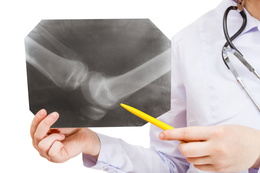When non-surgical treatment options for knee arthritis are not very helpful, surgery is recommended to relieve its symptoms. Here is some useful information about knee surgery for the treatment of arthritis.

Arthritis is a degenerative disorder of joints, which causes the breakdown of cartilage, resulting in inflammation and swelling of joints. Osteoarthritis is the most common form, which affects knee joints. It is also caused by gout, rheumatoid arthritis, post-traumatic arthritis, or infection. Age (people above 50 years), being overweight, injuries, trauma, ligament damage, deposition of uric acid crystals, and abnormal body structure are the common risk factors for this disease.
A person with knee arthritis may experience pain during activities, along with joint swelling and tenderness, stiffness of knee, cracking noise, and limited range of motion. It is diagnosed with the help of physical examination and findings of imaging tests such as X-ray and MRI scan. It can be treated using non-steroidal anti-inflammatory drugs (NSAIDs), support braces, physical therapy, muscle relaxants, and heat and cold treatments. Since obesity is one of the risk factors for knee arthritis, losing excess weight and maintaining a normal body weight is an important regimen for its treatment. A well-planned exercise program can help to reduce the stiffness in joints and improve the range of motion. When these treatment options are not helpful in relieving the symptoms, an orthopedist may recommend a knee surgery.
Arthritis Treatment with Knee Surgery
Knee surgery for arthritis is aimed at relieving joint pain, reducing joint stiffness, as well as improving the range of motion and appearance of deformed joints.
Arthroscopy: Arthroscopy is the surgical procedure, which provides a direct view of the joint structure with the help of an arthroscope. Since the arthroscope is attached to a closed-circuit television, arthroscopic surgery can be used to determine the type of arthritis and the amount of damage to the knee joint. It can be performed under local anesthesia. Arthroscopic clean-out is beneficial in case of mild to moderate knee arthritis. However, the benefits of arthroscopic surgery are temporary and symptoms may reappear after some duration.
Synovectomy: This procedure can be performed as an open surgery or using an arthroscope. In this surgical procedure, diseased synovium (soft tissue joint lining) is removed. This helps in reducing the joint pain and swelling of rheumatoid arthritis. However, the results may be temporary and the synovium may grow back after some years.
Osteotomy: In most cases, some deformities of the legs may develop such as a bowleg or knock-knee, which can worsen the symptoms. These deformities can be corrected with the help of osteotomy. This surgical procedure involves cutting and repositioning the bone, either tibia or femur bone, due to which the alignment of the leg is improved. This helps to relieve pain and manage the symptoms of arthritis.
Arthroplasty: Arthroplasty involves rebuilding of knee joints. It is also referred to as total joint replacement, in which a part or the entire arthritic joint is removed. Generally, it is replaced with ceramic, plastic, or metal parts. In this surgical procedure, the end of the bone where the cartilage has worn away is resurfaced. This procedure enables many people with disabilities to regain joint activity.
Unicompartmental knee replacement: This surgical option is considered to be a good treatment option for osteoarthritis of the knee joint. Out of the two compartments of a knee, only one compartment may be affected by arthritis, while the other may be normal. This minimally invasive surgical procedure involves replacement of only the damaged parts of one compartment. This surgery is beneficial for people with severe knee arthritis. Major benefits of this surgery are smaller incisions, less blood loss, and shorter duration for recovery. It helps to reduce symptoms and improves the range of motion. However, the main disadvantage of it is that the non-replaced compartment may deteriorate over time.
Total knee replacement: Total knee replacement is necessary in most cases. People with hampered joint mobility, malfunctioning joints, and limited activities due to joint pain are recommended to undergo this surgery. In this surgical procedure, the ends of the damaged lower leg bones and thighbones, as well as the kneecap are replaced with artificial implants made from plastic or metal. The artificial joint is connected to the shin, thighbone, and kneecap using cement or a special material. There are different types of implants such as cemented and press-fit knee replacements. The complete surfaces at the ends of the thighbone and lower leg bone are replaced. Most often, general anesthesia is preferred for this surgery. These implants can last for about 10-15 years in 90-95% of the patients. It helps to relieve pain and stiffness in joints to improve their mobility and functionality.
Knee surgery is one of the most effective options for arthritis treatment, which helps to relieve painful symptoms and restore normal functionality of the knee joints. This enables a person to perform daily routine activities with ease.


 Arthritis is a degenerative disorder of joints, which causes the breakdown of cartilage, resulting in inflammation and swelling of joints. Osteoarthritis is the most common form, which affects knee joints. It is also caused by gout, rheumatoid arthritis, post-traumatic arthritis, or infection. Age (people above 50 years), being overweight, injuries, trauma, ligament damage, deposition of uric acid crystals, and abnormal body structure are the common risk factors for this disease.
Arthritis is a degenerative disorder of joints, which causes the breakdown of cartilage, resulting in inflammation and swelling of joints. Osteoarthritis is the most common form, which affects knee joints. It is also caused by gout, rheumatoid arthritis, post-traumatic arthritis, or infection. Age (people above 50 years), being overweight, injuries, trauma, ligament damage, deposition of uric acid crystals, and abnormal body structure are the common risk factors for this disease.